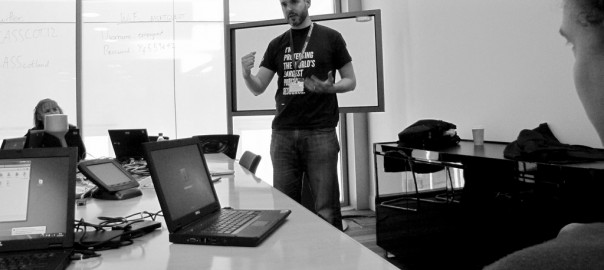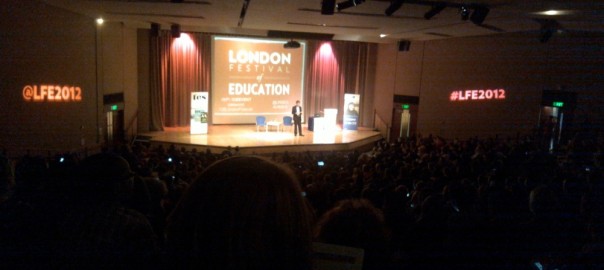I was invited to participate in a panel session as part of the inaugural London Festival of Education today. It was a great event with some big name speakers as well as thoughtful contributions from those at the sharp end in the classroom. I’ve written it up in a combined post with MozFest on my conference blog.
As ever with panel sessions I didn’t get a chance to say all I wanted to say about the topic of the session, which was entitled How learning technologies are changing teaching. The session description revealed more: “Slates and chalk have been replaced with iPads, and blackboards by interactive whiteboards. But is it the same old teaching just with fancy new kit?”
Writing up the notes from this session in an organised, coherent way would require a book. And I’ve already got one of those to write. So I’m afraid you’ll have to make do with the following:
- Wouldn’t it be great if we had a national agency to advise schools on how to use technology effectively? Although it was far from ideal, Becta was that agency. And we’ve thrown the baby out with the bathwater.
- The classroom is a symbol of intergenerational solidarity and conflict. Because it symbolises a shared experience it’s a contested space everyone thinks they’re an expert upon.
- Focusing on specific examples can be limiting. I caught the end of a discussion as part of the Today programme BBC Radio 4 on Thursday morning. The representative from Nesta was asked for an example of ‘a really good lesson’ using tablet computers. Quite rightly they didn’t attempt to answer the question. I think I’d have been tempted to throw the question back at them and ask what a really good lesson using pencils would look like.
- Technologies are more than just tools. And they’re not ‘neutral’. They were designed by someone, or a group of people, or a multi-national profit-seeking organisation for a particular purpose.
“A bias is simply a leaning – a tendency to promote one set of behaviours over another. All media and all technologies have biases. It may be true that “guns don’t kill people, people kill people”; but guns are a technology more biased to killing than, say, clock radio. Televisions are biased toward people sitting still in couches and watching. Automobiles are biased toward motion, individuality, and living in the suburbs. Oral culture is biased towards communicating in person, whilst written culture is biased toward communication that doesn’t happen between people in the same time and place.” (Douglas Rushkoff)
- Different technologies have different affordances. They may look the same and be put in the same categories by retailers and reviewers, but the opportunities they afford are different. This isn’t to do with cost, it’s to do with the logic of the device. So with some devices the trade-off you get for them being extremely easy-to-use is being locked into a proprietary ecosystem.
- Technologies do not operate in a vacuum. How, why and where technologies are used depends upon our values, expectations and motivations.
“When technologies are released, they are adopted and appropriated within existing social values, structures and expectations; they are shaped and reshaped by beta testers, early adopters and marketers; and they come to mean different things and be used for different purposes by different people. Different social, religious and cultural values, for example, pattern the uptake of medical technologies… [and] domestic technologies are appropriated into the existing values and cultures of families.” (Keri Facer)
- We can’t engineer future-proof schools. The future doesn’t just happen, it’s created by all of us. We shouldn’t be at the whim of people trying to make a profit by selling things.
“Rather than envisaging a ‘future-proof school that tries to insure itself against socio-technical change, therefore, we have the opportunity to create future-building schools that actively support their communities to tip the balance of socio-technical change in favour of fair, sustainable and democratic futures.” (Keri Facer)
- Doing the wrong thing faster or better isn’t progress. Going further down a wrong road doesn’t mean you’re going to get to the destination you had in mind. We need to re-think how we measure learning. If educators feel that something is valuable but it doesn’t necessarily lead to better test scores, then we need to re-think the tests.
“You can’t take on twenty-first-century tasks with twentieth-century tools and hope to get the job done.” (Cathy Davidson)
“As Internet analyst Clay Shirky notes succinctly, “Institutions will try to preserve the problem to which they are the solution.” (Cathy Davidson)
- Spending all day looking at screens is a bad thing. But technology can augment what we do. Think of sports tracking utilities that enable you to compete against yourself. Or track the number of steps you do and upload it to a website. Personalised, embedded technologies are a huge leap forward in terms of what we can do with learning and teaching. The example usually used is having a search engine in your pocket, but infinitely more powerful is a network of people – human agency – on tap. It can turn everyone into a superhero, compared with the 20th century.
- Concerns about the impact of technology on the brain are often misguided. The brain is supposed to rewire itself. How else could you learn anything?
“Many of our anxieties about how the new digital technologies of today are “damaging” our children are based on the old idea of neural development as fixed, or “hardwired.” and on notions of distraction and disruption as hindrances instead of opportunities for learning. Our fears about multitasking and media stacking are grounded in the idea that the brain progresses in a linear fashion, so we are accumulating more and more knowledge as we go along. Most of us, as parents or teachers or educational policy makers, have not yet absorbed the lessons of contemporary neuroscience: that the most important feature of the brain is Hebbian, in the sense that the laying down of patterns causes efficiencies that serve us only while they really are useful and efficient. When something comes along to interrupt our efficiency, we can make new patterns.” (Cathy Davidson)
- Instead of platforms as standards we should focus on standards as standards. We like to belong to things that are popular. That’s why technologies – including social networks – have a tipping point, but also a lifecycle. Just as an example, go to a conference and ask if anyone can lend you an iPhone charger. You’ll be inundated. Yet there are actually more phones with micro-USB chargers – and, in fact, it’s an EU regulation that users can use this standard to charge their phone. It’s a less extreme example of breast milk versus powdered milk in developing countries – there’s no-one to champion the former so those peddling the latter make millions.
- We need mind-expanding education and critical thinking skills, but we don’t need to regurgitate facts. There’s a quotation on the side of the British Library that I like:
“Knowledge is of two kinds. We know a subject ourselves, or we know where we can find information upon it.” (Samuel Johnson)
“The biggest problem we face now is the increasing mismatch between traditional curricular standards of content-based instruction and the new forms of thinking required by our digital, distributed workplace. at any level – blue collar or white collar – those jobs requiring “routine thinking skills” are increasingly performed by machines or outsourced to nations with a lower standard of living than [us].” (Cathy Davidson)
- Technology can be used well and technology can be used badly. Technology may have biases and affordances, but it can be bent to the will of human beings. There are rich, innovative, exciting and liberating uses of technologies. And there are dull, pointless, soul-sapping use of technologies. We need to use technology mindfully.
“The mindful use of digital media doesn’t happen automatically. Thinking about what you are doing and why you are doing it instead of going through the motions is fundamental to the definition of mindful, whether you are deciding to follow someone on Twitter, shutting the lid of your laptop in class, looking up from your BlackBerry in a meeting, or consciously deciding which links not to click.” (Howard Rheingold)
- We need to invest in training and peer assistance. Teachers are insanely overworked: no other industry would stand for it. And teacher CPD – especially around technology – is poor. More recently there’s been a fashion to say that learning technologies should be as easy to use as Facebook which is ridiculous. Most people were introduced to Facebook by family, a friend, or a colleague. They forget the learning curve and the constant re-learning they have to do when the interface and controls change.
- The skills, competencies and literacies we need now are different from those required in the past. It’s like a huge Venn diagram that’s constantly overlapping and moving. We’d do well to remember that we’re not trying to create adults like us but adults that will have the skills appropriate to the world in 10, 20 or 50 years’ time.
“I didn’t let my child loose on the streets without teaching her about traffic and looking both ways. Similarly, I don’t like to see otherwise well-educated people loose in digital culture without knowing something about what makes a small-world network work or why a portfolio of weak ties is important.” (Howard Rheingold)
“In previous eras, it may have been true that “it’s not what you know but who you know.” Today how you know what you know matters as much as who you know, and one of the most valuable traits a person could have in a twenty-first-century organisation is a knack for knowing “who know who knows what.”” (Howard Rheingold)
- We need names for things so that we can easily have conversations about them. Take, for example, the concept of the flipped classroom (where content is ‘delivered’ at home and activities take place during lesson time). Forward-thinking educators have been doing that for years, but now it has a delivery channel (YouTube, Facebook, etc.) and a name. It’s a thing.
- Learners will almost always know more about technology than their teachers. That’s not a reason to avoid using technologies, that’s a reason to embrace them. It’s empowering and demonstrates the teacher as lifelong learner. It’s scary to let go of the reins, but hugely beneficial and changes the dynamic of the classroom.



![[INCOMING] #BelshawBlackOps12](https://dougbelshaw.com/blog/wp-content/uploads/2012/11/iamwhoiam2-604x270.jpg)